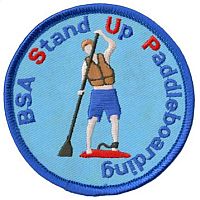TEMPORARY PATCH
The stand-up paddleboarding (SUP) emblem is designed to encourage Scouts to develop paddling skills that promote fitness and safe aquatics recreation.
The 3" round emblem features a stand-up paddleboarder against a bright blue twill background, and is worn as a temporary patch..
Requirements
- Review the BSA Safety Afloat policy. Explain to your instructor how this applies to stand up paddleboarding.
- Before fulfilling other requirements, successfully complete the BSA swimmer test: Jump feet first into water over the head in depth, level off, and begin swimming. Swim 75 yards in a strong manner using one or more of the following strokes: sidestroke, breaststroke, trudgen or crawl; then swim 25 yards using an easy, resting backstroke. The 100 yards must be completed in one swim without stops and must include one sharp turn. After completing the swim, rest by floating.
- Explain safety considerations for stand up paddleboarding in the following environments: lake, moving water, whitewater, open ocean, ocean surf.
- Review the characteristics of life jackets most appropriate for stand up paddleboarding and understand why one must always be worn while paddling. Then demonstrate how to select and fit a life jacket for stand up paddleboarding.
- Describe the correct type of leash to wear in the appropriate water venues.
- Name and point out:
- The major parts of a stand up paddleboard
- The parts of a paddle for stand up paddleboarding
- Discuss:
- The different types of stand up paddleboards
- How to correctly size and hold a paddle for stand up paddleboarding
- Using a properly outfitted stand up paddleboard, demonstrate the
following:
- How to safely carry a stand up paddleboard
- How to safely paddle away from a dock or shoreline (on knees)
- How to stand and balance on a board in the neutral position
- How to appropriately fall off a board
- How to remount the board
- Forward stroke
- Back stroke
- Forward sweep
- Reverse sweep
- Draw stroke
- One self-rescue technique—lay on your stomach and paddle with your hands
- With supervision from your instructor, paddle a course that involves:
- A straight line for 25 yards and stop within one board length
- A figure 8
- Moving abeam to the right 10 feet and to the left 10 feet








